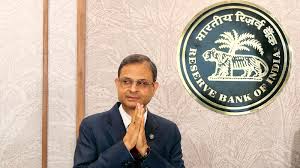RBI Governor Malhotra says rate cut likely ‘if inflation moderates or growth weakens’

In a crucial statement that could shape the direction of India’s monetary policy, Reserve Bank of India (RBI) Governor Sanjay Malhotra has hinted at the possibility of an interest rate cut in the near future—if inflation continues to decline or economic growth shows further signs of weakening. His remarks come at a time when India’s economy stands at an inflection point, balancing between moderating inflation and uncertain growth momentum.
Inflation Slides to Multi-Year Low
One of the key reasons behind Governor Malhotra’s cautious optimism is the significant moderation in consumer price inflation. According to recent data released by the Ministry of Statistics, India’s retail inflation rate dropped to 2.1% in June 2025, marking a 77-month low. This is well below the central bank’s target of 4%, and near the bottom of its tolerance band of 2%–6%.
The steep fall in inflation has been driven largely by a sustained decline in food prices, especially vegetables, cereals, and pulses. The effects of favorable monsoon rains, improved food supply chains, and global commodity price softness have played a substantial role in easing pressure on household budgets.
Malhotra emphasized, “We are closely monitoring inflation trends. If inflation remains subdued, we will have more space to take a policy decision that supports growth.” His words suggest that the central bank is maintaining flexibility, weighing both inflation and growth parameters before making a decisive move.
Economic Growth Losing Steam
While inflation is under control, the other part of the equation—economic growth—is showing early signs of fatigue. India’s gross domestic product (GDP) growth for FY 2024–25 is projected at 6.5%, in line with RBI’s estimates, but recent indicators point to possible softness in urban demand.
Car sales, housing demand, and credit off-take in consumer segments have slowed down compared to the previous fiscal year. Consumer confidence, while stable, has not rebounded as expected after the COVID-era stimulus faded. Rising unemployment among younger demographics, especially in urban centers, has also put a dent in spending patterns.
The RBI is aware that without adequate policy support, demand-side pressures could weigh on medium-term growth. Governor Malhotra noted, “Price stability remains a priority, but we cannot ignore the broader growth dynamics. If needed, we are prepared to act in a calibrated manner.”
Policy Direction: Waiting for the Right Signal
The RBI’s current stance remains neutral, a position that allows the central bank the flexibility to either ease or tighten policy depending on how macroeconomic indicators evolve.
In the past three monetary policy meetings, the central bank has already cut the repo rate by 100 basis points to 5.75%. A further rate cut could inject fresh liquidity into the banking system, reduce borrowing costs for businesses and individuals, and encourage capital investment.
However, analysts believe the RBI will likely wait until the next two rounds of inflation and IIP (Index of Industrial Production) data are released before making its move. A clearer signal on rural demand, credit growth, and employment will also factor into the final decision.
A rate cut, if executed at the August or October policy review meetings, could also boost investor sentiment and possibly push the equity markets higher. Yet, the central bank must tread carefully—it does not want to stimulate demand too rapidly, which could stoke inflation again.
Global Comparisons and Caution
India is not alone in this balancing act. Several major economies, including the U.S., Eurozone, and parts of Asia, are facing similar dilemmas. Central banks globally are navigating a post-pandemic landscape characterized by uncertain growth trajectories and persistent geopolitical risks.
The U.S. Federal Reserve has held interest rates steady amid cooling inflation, but concerns about a recession still loom. Meanwhile, the European Central Bank has signaled a dovish tone, hinting that rate cuts may come sooner than expected.
In contrast, the RBI has been more measured. Its approach reflects India’s unique challenges—such as high informal employment, a consumption-driven economy, and vulnerabilities in the rural sector. Malhotra’s comments suggest that while India may consider easing monetary policy, it will do so only when absolutely warranted by data.
Impact on Borrowers, Businesses, and Markets
If a rate cut does occur, it could provide relief to homebuyers, car buyers, and businesses with outstanding loans. A lower repo rate typically leads to a fall in lending rates across the banking system, making loans cheaper.
Startups and MSMEs, many of whom have struggled with high borrowing costs, could also see an opportunity to ramp up investment and operations. Real estate developers, too, are hoping for a rate cut to rejuvenate housing demand, particularly in Tier-2 and Tier-3 cities.
On the flip side, fixed income investors may need to recalibrate expectations, as returns from government and corporate bonds could fall slightly if yields follow the repo rate lower.
Looking Ahead: Cautious Optimism
As the RBI walks the tightrope between supporting growth and maintaining price stability, Malhotra’s message is clear: the central bank will not hesitate to adjust its stance if either inflation or growth metrics warrant action. For now, the tone remains data-dependent and flexible.
In the coming months, all eyes will be on economic indicators—especially food inflation, fuel prices, credit disbursement patterns, and consumption data. These will ultimately determine whether the RBI follows through with another rate cut or maintains the status quo.
Conclusion
Governor Malhotra’s nuanced statement reflects the RBI’s evolving strategy in a changing economic environment. With inflation under control and growth slightly underwhelming, the door to further monetary easing is open—but not guaranteed. India’s central bank remains cautious but ready to act. For investors, borrowers, and businesses alike, the next few months could be decisive in shaping the economic narrative for the rest of 2025.






